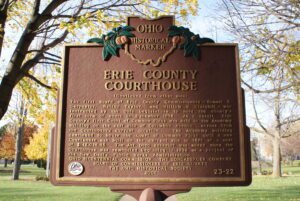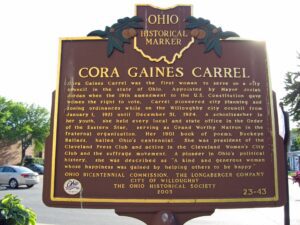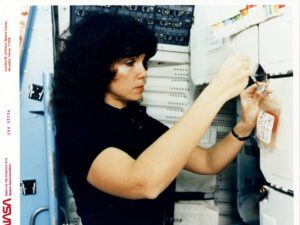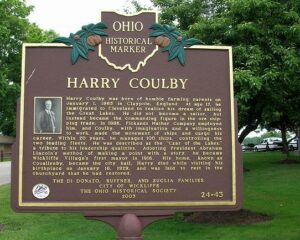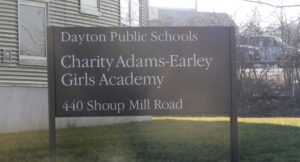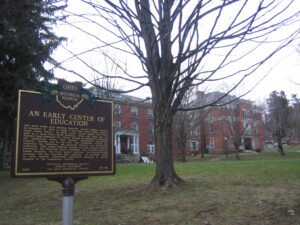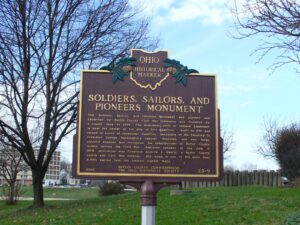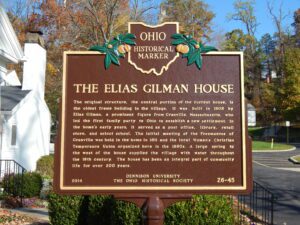, OH
Jury of Erie County Women, First to be Impaneled Under Federal Suffrage proclaimed the headline of the Sandusky Register on August 28, 1920. One of the first female Court of Common Pleas juries in the nation was impaneled in Erie County on August 26, 1920, moments after the 19th amendment to the Constitution of the United States was declared ratified. On that date, Judge Roy Williams was to conduct a trial and jurors were needed. Out of the ten men he contacted, only one could serve. Frustrated, Judge Williams later told the women, “When I learned shortly after 10:30 this morning that suffrage had been proclaimed, I decided to impanel a woman jury. Twelve women were summoned. Twelve women served.” (continued on other side)
, OH
Cora Gaines Carrel was the first woman to serve on a city council in the state of Ohio. Appointed by Mayor Josiah Jordan when the 19th amendment to the U.S. Constitution gave women the right to vote, Carrel pioneered city planning and zoning ordinances while on the Willoughby city council from January 1, 1921 until December 31, 1924. A schoolteacher in her youth, she held every local and state office in the Order of the Eastern Star, serving as Grand Worthy Matron in the fraternal organization. Her 1901 book of poems, Buckeye Ballads, hailed Ohio’s centennial. She was president of the Cleveland Press Club and active in the Cleveland Women’s City Club and the suffrage movement. A pioneer in Ohio’s political history, she was described as “A kind and generous woman whose happiness was gained by helping others to be happy.”
, OH
“The future doesn’t belong to the fainthearted; it belongs to the brave. The Challenger crew was pulling us into the future and we’ll continue to follow…” President Ronald Reagan
As the second American woman in space, Judith Resnik (1949-1986) paved the way for the future of women in space exploration. A gifted science and music student and valedictorian of Firestone High School’s class of 1966, she earned a doctorate in Electrical Engineering from the University of Maryland in 1977 and was accepted by the National Aeronautics and Space Administration (NASA) as an astronaut candidate in 1978. Her first flight was on the inaugural mission of the Space Shuttle Discovery in 1984. Resnik was aboard the Space Shuttle Challenger as a mission specialist on January 28, 1986, when it exploded just 73 seconds after lift-off from the Kennedy Space Center in Florida. All seven crewmembers died in the explosion.
, OH
Harry Coulby was born of humble farming parents on January 1, 1865 in Claypole, England. At age 17, he immigrated to Cleveland to realize his dream of sailing the Great Lakes. He did not become a sailor, but instead became the commanding figure in the ore shipping trade. In 1886, Pickands Mather Company employed him, and Coulby, with imagination and a willingness to work, made the movement of ships and cargo his career. Within 20 years, he managed 100 ships, controlling the two leading fleets. He was described as the “Czar of the Lakes,” a tribute to his leadership qualities. Adopting President Abraham Lincoln’s method of making a point with a story, he became Wickliffe Village’s first mayor in 1916. His home, known as Couallenby, became the city hall. Harry died while visiting his birthplace on January 18, 1929, and was laid to rest in the churchyard that he had restored.
, OH
In 1942, Charity Adams Earley (1918-2002) became the first African American woman to receive a commission in what became the Women’s Army Corps (WACs). She rose through the ranks to command the 6888th Central Postal Directory Battalion in Europe, the only unit of African American women to serve overseas in World War II. Upon leaving the service in 1946, she was the WAC’s highest-ranking African American officer, a lieutenant colonel. Raised in Columbia, South Carolina, Earley moved to Ohio to attend Wilberforce University and later The Ohio State University. She married Stanley Earley, Jr., M.D. in 1949 and they later moved to Dayton. She became active in civic affairs, including serving on the Sinclair Community College Board of Trustees.
, OH
Just three weeks after reaching Granville, pioneer villagers decided on December 9, 1805 to build a log cabin where eighty children would attend school. By 1820, public school classes were being held in a three-story brick building. When rail lines and the National Road bypassed the village, dreams of becoming an industrial and commercial center were dashed. Educational institutions, however, thrived and by the Civil War Granville’s citizens had organized the following: the Granville Literary and Theological Institution, later called Granville College and then renamed Denison University; the Granville Female Seminary, the Granville Episcopal Female Seminary, the Young Ladies’ Institute, the Granville Female Academy, and the Granville Male Academy. As Granville enters its third century, educational excellence continues to attract students to the community’s schools.
, OH
The Soldiers, Sailors, and Pioneers Monument was planned and promoted by Butler County Civil War veterans and financed by a county levy in 1899. The monument, built of Indiana Limestone, is near the center of the site of Fort Hamilton, built in 1791 and named in honor of Alexander Hamilton, Secretary of the Treasury in President George Washington’s cabinet. Featured, are two large, colorful windows that recognize the contributions of Butler County women during the Civil War. Featured speaker at the July 4, 1906, dedication was Governor Andrew L. Harris, a Butler County native and Civil War veteran. His name is one of the more than 4,300 carved into the interior marble walls.
, OH
The original structure, the central portion of the current house, is the oldest frame building in the village. It was built in 1808 by Elias Gilman, a prominent figure from Granville Massachusetts, who led the first family party to Ohio to establish a new settlement . In the home’s early years, it served as a post office, library, retail store, and select school. The initial meeting of the Freemasons of Granville was held in the home in 1811 and the local Women’s Christian Temperance Union organized here in the 1880s . A large spring to the west of the house supplied the village with water throughout the 19th century . The house has been an integral part of community life for over 200 years.


